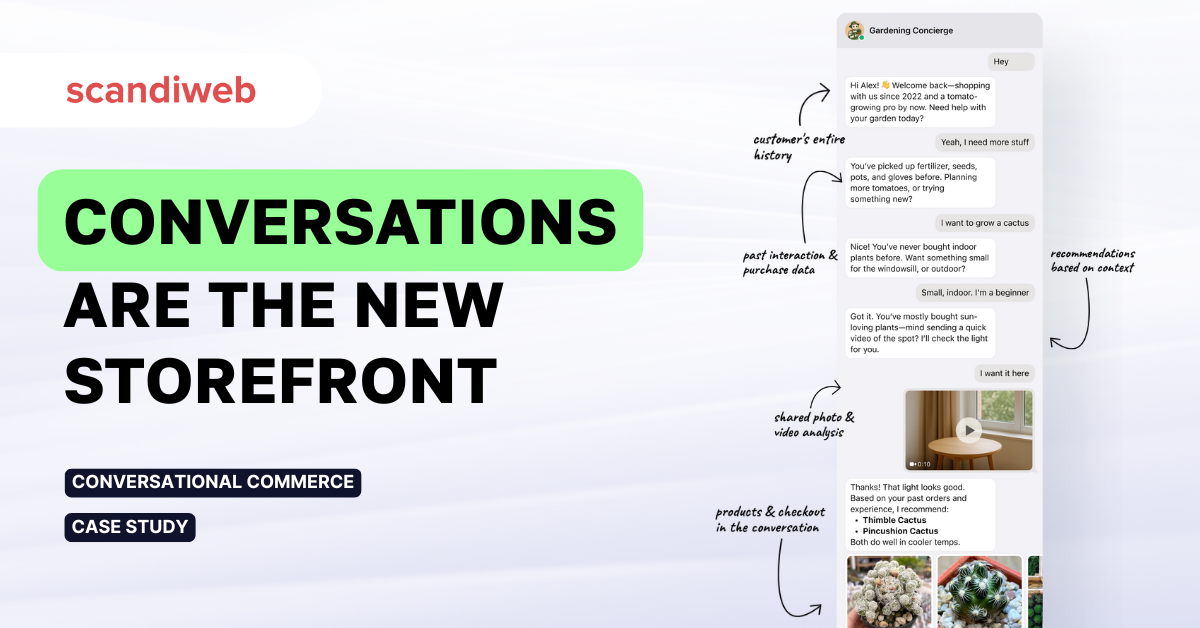You don’t need a website visit to make a sale anymore.
More and more, shopping starts with a message: a quick question about sizing, a request for a gift recommendation, a reply to a product suggestion sent last week, or a follow-up from a customer wondering if something’s back in stock. And when the conversation feels natural and helpful, it often ends with a purchase.
That’s conversational commerce.
It brings the buying experience into chat on any platform through assistants that engage in real time, respond with context, and guide customers toward what they’re likely to buy. Conversational commerce means dynamic conversations shaped by customer behaviour, preferences, and past interactions and overall context.
Brands adopting this approach will reduce friction and convert interest into revenue without forcing users through long browsing sessions. Leading brands worldwide are already testing it – you can launch it! Let’s look closer at how conversational commerce works in practice, where it’s making the biggest impact, and what to consider if you’re considering launching your own.
Key takeaways
- Conversational commerce brings the shopping experience into real-time chat, helping customers find and buy products through natural 1:1 conversation.
- Success depends on clean product data, clear use cases, strong brand voice, real-time integrations, and continuous optimization.
- With the proper setup, brands can shorten buying journeys, increase AOV, and reduce support pressure without sacrificing user experience.
- scandiweb built an AI assistant for a leading Nordic DIY retailer to guide project-based shopping, leading to 95% higher AOV and a 68% increase in conversions.
What is conversational commerce, really?
Conversational commerce is a new way of selling through real-time dialogue. Instead of browsing a site, clicking, scrolling, and navigating between tabs, customers get help through a conversation. No less than one that feels personal and focused on what they actually need.
It can happen anywhere your customers already are: on your website, in a native app, over chat platforms, or even via SMS. What matters more than the channel is the experience. Your customer asks a question, gets a response, and moves forward with clarity.
Unlike traditional chatbots, modern conversational commerce tools don’t rely on scripts. Instead, they draw on customer data about past interactions with your brand and product details to guide the conversation. This makes the assistant more useful and part of the shopping journey. Done right, it’s fast, helpful, and completely integrated with how shoppers already prefer to communicate.
Why brands are investing in conversational commerce
91% of consumers globally say they’re more likely to shop with brands that offer real-time assistance. And according to industry experts, messaging will be the fastest-growing commerce channel by 2026.
Customers have grown used to getting fast, tailored responses across every platform they use. That expectation doesn’t stop at eCommerce. When someone is ready to buy or has a question holding them back, they want clear answers immediately without switching channels.
🚀 Quick takeaway
91% of shoppers want real-time support. Brands using conversational commerce are seeing faster checkouts and fewer drop-offs.
Conversational commerce shortens the time between interest and purchase and reduces drop-offs, especially for returning users. It also creates more opportunities to re-engage customers based on real data. Leading brands recognize that this means moving closer to the customer decision point without adding complexity to internal teams.
What makes it work (and what doesn’t)
AI-powered chat can increase conversion rates by up to 30% when used for guided selling. For conversational commerce to deliver such results, here’s what needs to be in place:
- The assistant has access to clean, connected product data and up-to-date info on inventory, pricing, and attributes; if it can’t answer basic questions or suggest available alternatives, the conversation breaks.
- Clear use cases and goals, like recommending products, handling repeat questions, or guiding through gift selection; otherwise, a broad, unfocused assistant often leads to more confusion.
- Assistants that respond based on real-time behavior, recent views, and purchases feel more helpful – context is everything.
- The assistant should speak in a voice that fits your brand and sound natural and human.
- The experience has to feel instant, like chatting with someone who knows the answer before you finish asking and can suggest things you didn’t even think to ask.
Where things fall apart are generic bots with no access to product or user data and overcomplicated flows that trap the user between decisions.
Conversational commerce in practice
At scandiweb, we’ve built Concierge AI: a conversational digital assistant that feels like a boutique-style concierge. These are examples of how we see it working across different industries, based on real customer needs and typical customer profiles and shopping behaviors.
🚀 Quick takeaway
Use cases that work: recommending full routines, referencing past orders, adapting to stock in real time, supporting multi-customer logic.
Curated product discovery
A digital beauty assistant curates full routines beyond answering your customer’s questions. After identifying the customer’s current preferences and routines, it can recommend contour, blush, lip, brush, and highlighter products that match tone and texture. Product education woven into every suggestion guides the customer through a feel-good, ultra-personalized routine, like chatting with a knowledgeable in-store rep, only faster.
Retention & gifting
When a returning customer asks for gift recommendations in his favorite watch store, the assistant instantly can reference previous orders and suggest alternatives, highlighting subtle style differences, showing product images, and offering advice on what to wear for a big event.

Multi-customer logic
A sports store customer chats in to refresh her son’s training gear. The assistant recalls previous purchases, adapts to sizing needs, and recommends tennis-appropriate shoes, even when faced with stock limitations. If a favorite item is out of stock, it can offer brand alternatives instead, tell about pricing options, and style-matching picks for mother and child, creating a helpful shopping experience (in any language, may we add).


Case study: scaling DIY sales with AI-powered guidance
Our client, a leading Nordic home improvement and DIY retailer with over 200 stores, over $1B in annual revenue, and a fast-growing eCommerce channel, serves customers across Sweden, Norway, Finland, and Denmark.
They want to help customers who come in with a project idea, like building a deck or updating a patio, but don’t know what products, sizes, or quantities they actually need.
Here’s the problem.
Around 70% of annual revenue is concentrated between May and September. To support this seasonal spike, our client expands its workforce by up to 10x, primarily hiring temporary staff who need to quickly learn key product knowledge, how to talk to customers about their projects, and how to answer common in-store questions.
The training process was too slow and inconsistent to keep up. So we helped them introduce an AI-powered assistant trained on common DIY projects and linked to their full product catalog.
Project goal
Many customers walk in with a project idea but no clear understanding of what materials are required. They know what they want to build, but not the SKUs, sizes, or product combinations they need. To serve these customers better and increase basket size, this retailer needed a scalable solution to guide customers through their projects and toward purchase.
Solution
In collaboration with Algoritma, we built an AI-based ShopBot, accessible on the website. It’s trained on common DIY projects and connected to the retailer’s full product catalog. The assistant can:
- Advise on how to complete specific projects, step by step
- Recommend exact SKUs, sizes, and quantities for the task
- Provide consistent, 24/7 guidance without human staff.
How to get started
You don’t need to launch on every platform or build a fully autonomous AI from day one. But if you want conversational commerce to drive results, it needs a solid foundation.
Here’s what the process looks like:
- Prepare your data foundation for AI
Clean product data, enriched attributes, and organized customer behavior logs give your assistant something to work with. The better the input, the more useful the conversation.
- Build your custom conversational agent and create the interface
The interface should fit naturally into your existing flow – on-site, in-app, or embedded in chat, and be able to handle your real use cases.
- Train your assistant to sound human and on-brand
Scripted or AI-generated, your assistant needs to reflect your tone in how it responds, how much detail it gives, and so on.
- Connect the agent with your eCommerce & other platforms
To stay helpful, the assistant needs access to current inventory, pricing, customer profiles, and order history. Integrations with your eCommerce platform, CDP, and analytics tools make this possible.
- Track interactions to fine-tune offers and timing
Monitor how users engage with the assistant. Where do they drop off? What prompts convert? This feedback loop lets you adjust conversation flows, tweak recommendations, and improve overall performance over time.
Start small. Test a focused use case. Then scale once the assistant proves it can make the experience faster and more helpful.
Before you know it, the best salesperson will be in your customer’s pocket.
If you’re curious how conversational commerce could work for your brand, let’s schedule a free consultation! We’ll build a tailored demo with your products and typical customer profiles to show what’s possible.



Share on: